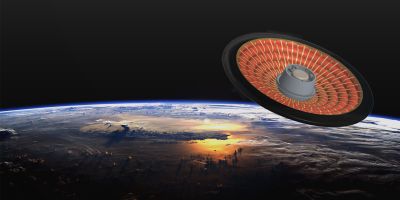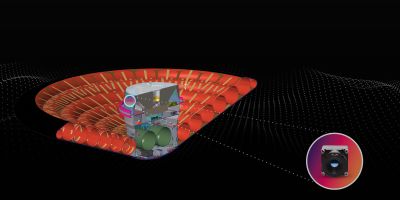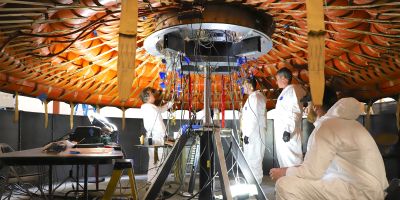![]()
NASA išsiunčia Teledyne FLIR Boson šiluminės kameros modulį iš šio pasaulio
NASA Takes the Teledyne FLIR Boson Thermal Camera Module Out of this World
![]()
NASA išsiunčia Teledyne FLIR Boson šiluminės kameros modulį iš šio pasaulio
NASA Takes the Teledyne FLIR Boson Thermal Camera Module Out of this World
NASA Maršalo kosminių skrydžių centro inžinierių pastangomis Teledyne FLIR "Boson“ šiluminės kameros modulis yra pasirengęs išeiti už atmosferos ribų.
Miniatiūrinė „Boson“ terminio vaizdo sistema mato šiluminę energiją ir pateikia tikslius atskirų temperatūrų matavimus. NASA pakuotėje yra sumanių sprendimų, leidžiančių jam išgyventi pačiomis ekstremaliausiomis įmanomomis sąlygomis – nuo intensyvios vibracijos pakilimo metu iki kosmoso vakuumo, o vėliau ir dėl temperatūros, pasiekiamos patenkant į Žemės atmosferą.
NASA pasirinko „Boson“, nes jis jau atitinka daugelį griežtų inžinerinių reikalavimų, įskaitant mažus gabaritus, mažą svorį, pasyviai aušinamą infraraudonųjų spindulių kamerą su 640 x 480 šilumine skiriamąją geba. Platforma taip pat puikiai tinka pritaikymui ir pakavimui, kad išgyventų kosminių kelionių sunkumus.
NASA sukurtas „Boson“ ir paketas buvo pilnai išbandytas ir pripažintas tinkamu pagal technologijos parengties 8 lygį, kad galėtų veikti tokiomis sąlygomis, kaip didelė vibracija, smūgis, vakuumas, didelė spinduliuotė ir temperatūros sąlygose nuo ekstremaliai didelio šalčio iki ekstremaliai didelio karščio. Modifikuota "Boson" pakuotė taip pat galėtų būti tinkama naudoti ekstremaliomis sąlygomis žemėje, įskaitant aviaciją ir nepilotuojamas pramonės mašinas.
Thanks to the efforts of engineers at the NASA Marshall Space Flight Center, the Teledyne FLIR Boson thermal camera module is ready to venture beyond the atmosphere.
The miniature Boson thermal imaging system sees thermal energy and provides accurate stand-off temperature measurements. NASA’s packaging features clever modifications that enable it to survive in the most extreme conditions imaginable, from the intense vibrations at liftoff, to the vacuum of space, and then the temperatures reached during re-entry into Earth’s atmosphere.
NASA chose the Boson as it fits many of its stringent engineering requirements already, including the need for a small, lightweight, passively cooled infrared camera with 640x480 thermal resolution. The platform also lends itself well to customization and repackaging for surviving the rigors of space travel.
The Boson and package assembly developed by NASA has been fully tested and qualified at technology readiness level (TRL) 8 for operation in conditions including high vibration, shock, vacuum, high radiation, and temperature cycling from extreme cold to extreme heat. The modified Boson packaging could also serve as a potential option for use in the harshest of terrestrial conditions as well, including for aerospace and unmanned industrial machinery.
Pripučiamo grįžimo šilumos skydo testas
Pirmojoje savo misijoje kosminės klasės „Boson“ bus naudojamas NASA žemos Žemės orbitos pripučiamo lėtintuvo bandyme, iš esmės tai yra pripučiamo šilumos skydo veiksmingumo bandymas grįžtant į Žemės atmosferą.
„Boson“ bus įrengtas už šilumos skydo, ir jo tikslas yra stebėti infraraudonųjų spindulių spektre susidariusią šilumą, kai skydas leidžiasi atgal į Žemę. Pripučiamas, mažesnio svorio šilumos skydas gali būti labai naudingas būsimoms misijoms, nesvarbu, ar jos grįžta į Žemę, ar patenka į gretimų dangaus objektų atmosferą Saulės sistemoje. Modifikuotas „Boson“ taip pat galėtų būti naudojamas, kaip stebėjimo sistemų dalis ateities žemos Žemės orbitos palydovuose ir erdvėlaiviuose.
Inflatable Re-Entry Heat Shield Test
For its first mission, the space-grade Boson will be used as part of the NASA Low Earth Orbit Flight Test of an Inflatable Decelerator (LOFTID/IHAD), essentially a test of the effectiveness of an inflatable heat shield during re-entry into Earth’s atmosphere.
The Boson will rest behind the heat shield, with the goal of monitoring the heat generated in the infrared spectrum as the shield descends back to Earth. An inflatable, lighter-weight heat shield could provide significant benefits for future missions, whether that’s returning to Earth or entering the atmosphere of neighboring celestial objects within the solar system. The modified Boson could also be used as part of imaging systems for future low-Earth orbit satellites and spacecraft.
Tikimasi, kad pradinis bandymas prasidės 2022 m. lapkričio mėn. Sėkmingas bandymas padidins „Boson“ ir pakavimo technologijos parengties lygį iki 9 ir pakavimo mazgo, kas yra įmanoma pagal licenciją NASA technologijų perdavimo programoje.
Norėdami gauti daugiau informacijos apie „Boson“ šiluminio vaizdo kamerų šeimą, apsilankykite https://www.flir.com/oem/boson-family/.
Norėdami gauti daugiau informacijos iš NASA apie „Boson“ kosminį įvertinimą ir kūrimą Bosono kūrimą, apsilankykite NASA technologijų perdavimo programos svetainėje: https://technology.nasa.gov/patent/MFS-TOPS-108
The initial test is expected to commence November 2022. Successful testing will increase the TRL to level 9 for the Boson and packing assembly, which is available for license from NASA Technology Transfer Program.
For more on the Boson family of thermal imaging cameras, visit https://www.flir.com/oem/boson-family/.
For more on the development of the space-rated Boson from NASA, visit the NASA Technology Transfer Program website: https://technology.nasa.gov/patent/MFS-TOPS-108




